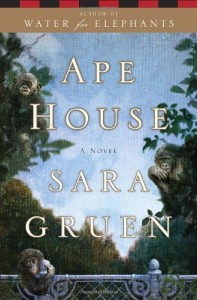Ape House by Sara Gruen

Before his piece hits the press, the lab is bombed, and the apes scatter among the trees. Isabel, who was in the lab watching a movie with the bonobos at the time, takes the brunt of the bomb, sustaining serious injuries. When it comes to light that a terrorist group takes credit for the bombing (to free the apes) and threatens worse damage, the dean of the school sponsoring the lab sells the bonobos to an entertainment guru who uses them to create a new reality TV show, Ape House, where the bonobos run the show. Isabel chases after the apes to rescue them, and John chases after the apes for the story (although altruistically, of course).
Gruen’s story is strongest when the plot moves naturally as she considers ethical questions about science and entertainment. Unfortunately, she attempts to pepper it with another circus-like crew and sideshows. Why we need the exploding meth-lab, for example, is beyond me. Because of her grasps at a unique cast, she ends up employing cliched characters–the prostitute with a big heart, the tattoed, hair-dyed intern with a big heart, the unshowered hackers with, yes, a big heart, you get the idea.
Also, at times her typically flowing prose falls into cliche and even cartoonish gesture–involuntary lip twitches, answering the land line when the cell phone rings, tripping over your own feet sort of thing. Other times, she gives us a sentence, a phrase, that perfectly encapsulates the scene, such as this: “Camera crews surfed the perimeter, sampling the groups as though they were dim sum.”
And, of course, as a writer, I couldn’t help but love this line: “At this moment, the story in his head was perfect. He also knew from experience that it would degenerate the second he started typing, because such was the nature of writing.” (Of course, following this, Gruen painstakingly and unnecessarily describes John’s writing and deleting work until he taps out that perfect story and Gruen taps out the reader’s patience.)
Ape House shows its true beauty when describing the interactions between the bonobos and the humans. And though Gruen’s caricature of Christians in the book is less than nuanced, it raises good questions for Christians to consider. If God tasked us with caring for his creation, how do we respond to abuses of animals, even when labs attempt to justify their tests as progress? Or how do we cultivate and enjoy creation without denigrating it in our insatiable quest for entertainment?
Despite overly complicated story lines and convenient turns in the plot, I recommend this book for its beauty in human-animal interaction and those moments when Gruen’s lyrical writing peeks through some of the slush. The story is moving for all its faults and has the capacity for challenging us in its social commentary.